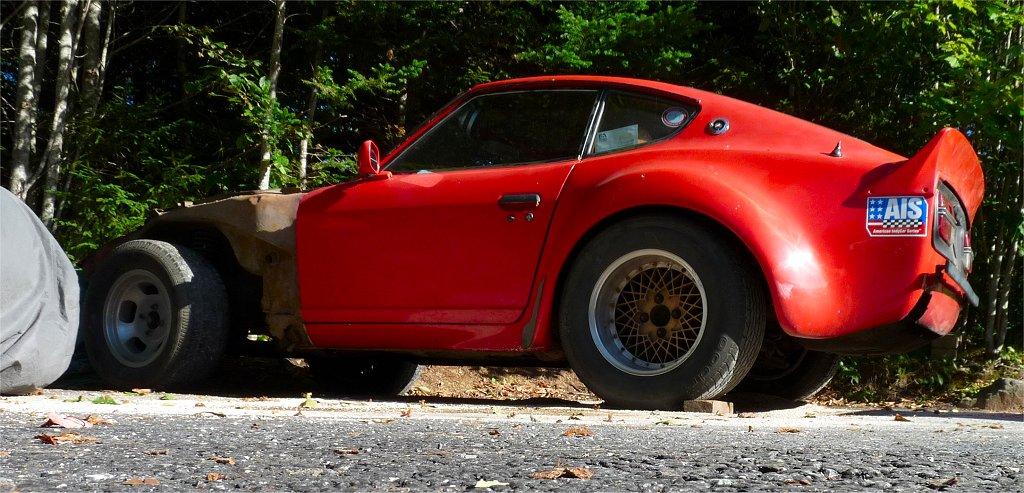
Everything posted by 240260280
-
Weber selection and initial jet tuning
For the rocker install: Turn cam so that the problem lobe is up. Install the lash pad. Place the rocker beside the lowered adjuster and fit the other end into the lash pad. Rotate the rocker toward the adjuster and try to lift its end up onto the adjuster's ball cap. If the pressure is too much, you can stick a very large screw driver between the spring retainer and the cam. Pry the retainer down by using the cam body (not the lobe) as the fulcrum. Obligatory WW image: If she were a president, she'd be Baberham Lincoln.
-
Technical Service Bulletin TS75-025
- 34 downloads
- Version 1.0.0
TSB addresses air tight connector in ignition that can cause intermittent spark.Free -
Weber selection and initial jet tuning
Good find! Glad it is not lower end. Sweep the head with a magnet (including springs) to try and find the broken pieces. Also put a super magnet on the outside of the oil pan near the drain to try and localize any debris. Remove the magnet when you drain the oil and hopefully it will be close enough to the drain to get carried out with the flow. For installing the rocker, you just need to wind down the adjuster all the way. Fit the rocker end between the cam and lash pad then pop the other end over the adjuster ball. Sometimes a long flat screwdriver helps as a lever to push down valve spring a wee bit. Be sure to inspect the cam lobe and two rocker faces for wear or damage. Excellent!
-
Weber selection and initial jet tuning
Rats.... good luck finding out what is going on.
-
Hardway's Red Rocket 1972 240z Build Thread
Get the spoke wheels that are for sale on this site then put some Ferrari Badges on it! Mess with their heads! Looks beautiful!
- SU carb-correct screw adjustment?
-
SU carb-correct screw adjustment?
If you use the "Snail" flow tool, it is designed for single cylinders (Weber DCOE typically) so the flow from the 3 combined cylinders drawing from each SU carb on a 240z makes it "pin" easily at >2000 rpms. Some of these snails have a hole in the side that can be exposed to reduce the air through the meter at high rpms. (see the hole in the side below). You may have to punch a hole in the inner rubber to make it work. Just rotate the inner rubber to close any hole you make.
-
Hardway's Red Rocket 1972 240z Build Thread
There is always a lot of Datsun "spirit" in your posts. Motivating like watching car restoration TV programs. For the chain slop, are you turning CW at the crank (ref. standing in front of car)? Usually the left side (ref. driver) has tension all the time when turning and when stopped so it will not flap that much until lifting pedal at high revs. The tensioner on the other side usually takes up the slop after the oil pressure is up so the slop will be less on the road... but as you say it does look like a lot of slop regardless. You can have a look for stretch by using the triangle cam sprocket markers at TDC. Check the inside of the valve cover above the chain to see if it left you any gifts. Maybe do a compression test too while you have the engine in the car before pulling it. You may want to do more when it is out
-
Hardway's Red Rocket 1972 240z Build Thread
Way to go! You da man!
- I have TSB's for Scanning
-
I have TSB's for Scanning
I can do it. I am posting Z stuff here: http://240260280.com/Docs/index.html I have 69-72 TSB's so those will be great to ad! I'll PM my address.
-
Caswell Plating
I looked up anode bag and lots of hits: https://www.alliedplating.com/product/anode-bags/
-
Caswell Plating
He also circulates the solution... probably a filter in there too. He bags the anodes with a permeable membrane to prevent particles and impurities from floating away and contaminating the solution.
-
Caswell Plating
Very nice... like jewels.
-
Cody's Goon
Drool! Nice work... wish you were closer to teach me!
-
Weber selection and initial jet tuning
I re-read the thread and checked on a few items. Here are my thoughts: 1. The 00 exhaust/spill/bleed-back jet could be the bug bear that has been on our back the whole time. It would cause the rich high rpm tilt that we have been trying to tune out with very large air correctors. 2. The 00 exhaust/spill/bleed-back jet could also be causing the rich dip when you start your run. The squirt of liquid fuel would be the reason. 3. The two above effects will cause the WOT run to always appear to have a hump in the middle and hide the subtle effects of the E-tube. 4. By adding a larger air corrector, to try and bring back the high end from its richness caused by the 00 exhaust, it also delays the E-tubes with the high holes from coming in early enough. The F16 is particularly affected by this due to its higher holes and it will come in later if the air corrector is too large. This will cause a flat spot between the progression circuit stopping and the main circuit starting. I also ran Weber's formulas for your engine and rpm range. - Ideal bore is 44.1mm so 45DCOE's are as good as it gets. - Ideal Venturi is 35.8mm for 6500rpm redline so your 34mm or 36mm would be fine. The carb and chokes you are using are well within the ideal range. In the spring I think the first order of business is to do a run with the 00 Exhaust in place and another with the Exhaust valves replaced by screws. This will help us better understand what that beastie is doing.
-
Weber selection and initial jet tuning
FYI what Passini says about Pump Jet leaking at WOT (btw Keith Franke claimed this did not happen). It is why I tune main circuit with bleed/spill jet's blocked. A very large pump jet can enrichen the top-end mixture to such an extent that a larger air corrector may be needed in order to prevent over-richness. This may, of course, in certain contexts achieve the desired mixture slope but, on the whole, large pump jets making up for the main system weakening off too much in the top range cannot be recommended. The pump jet is also in operation during full-throttle running. There being sufficient depression at high revs and a wide throttle opening to lift the weight holding down the delivery valve ball. Once the flow has been initiated, only the weight returning the ball to its seat will stop it entirely because the pump jet orifice lies below the fuel level in the float chamber. This is one important reason for not mounting DCOE carburettors with the trumpets tilted upwards more than about five degrees, or the siphon effect will overcome the weight and the flow will continue in the form of a dribble which will enrichen the mixture detrimentally. In addition to the depression in the venturi, high gas speeds past the pump jet are in themselves capable of drawing fuel because of the streaming effect of the low-pressure area which forms downstream of an obstruction (e.g. pump jet protrusion into the throat). The very mixed blessing conferred by the fact that there are, in most cases, several combinations of main jet, air jet, emulsion tube, nozzle, and pump jet (leaking) that will all produce the same flat-out (WOT) maximum power. None of these three items (rod length, discharge bleed, spring) have any effect on the delivery from the pump jet at full chat (WOT) when it is acting as a high-speed fuel bleed (leaking). Figure 5 shows that the pump jet is also in operation, there being sufficient depression at high r.p.m. and a wide throttle opening to lift the weight holding down the delivery valve ball. Once flowing, only the weight returning the ball to its seat will stop the flow entirely, because the pump jet orifice lies below the fuel level in the float chamber. This is one important reason for not mounting the DCOE carburettors with the trumpets tilted upwards more than about five degrees (absolute max: 7degrees), or the siphon will overcome the weight and the flow will continue in the form of a dribble and enrichen the mixture detrimentally. The pump jet is the only one that delivers fuel in liquid form and not as an emulsion. So, unless the gas velocity is sufficiently high there will be little break-up of the stream. High gas speeds past the pump jet in themselves are capable of drawing fuel due to a 'streaming' effect of a low pressure area downstream of an obstruction.
-
In Sioux Falls, SD inspecting the "Twins".
Hi Pop's it could also be something that crawls which is dropped from a drone. I see a lot of progress for finding victim's trapped in collapsed buildings after earthquakes so heat resistant variants would be good for sure.
-
Weber selection and initial jet tuning
Thanks for the update! I'm glad the tapping has gone. We can pick it up in the spring. I have been reading a great deal about DCOE's in the last month and it is possible the rich at high rpms could be due to the acceleration jet leaking. We can look into it in the spring. I should have my SK's running then and can work in parallel. Merry Christmas!
-
In Sioux Falls, SD inspecting the "Twins".
Excellent! Nice to hear! I think they will also be useful in man-down situations too.
-
In Sioux Falls, SD inspecting the "Twins".
I always thought FD's would exploit drones and send them out with the trucks to do early reconnaissance. A big bird to fly to the site and smaller UAV's inside the big one that could be dispatched into the site would help prep the team. Maybe I watched too much International Rescue/Thunderbirds as a kid.
-
Mikuni FI Prototype?
Not much to it: 1. The 240z fuel system has to go to high pressure so you just need a pump, filter, and high-pressure hose. Typically it makes a circuit so you re-use the send and return hard lines from/to the tank. 2. The manifold needs to be changed to one that takes injectors. 3. The injectors need to be sized to the engine demand. 4. An injector controller/driver and engine sensors are needed to drive the injectors based on the engine speed and load. 5. The controller system needs electricity from the existing 12V bus.
-
Hardway's Red Rocket 1972 240z Build Thread
Nice info here: http://www.alfabb.com/bb/forums/carburetors-fuel-injection-air-intake/101677-replacing-throttle-plates.html
-
Hardway's Red Rocket 1972 240z Build Thread
From CO's observation it may be best to simply re-use the original plate. Just solder up the hole and file the solder smooth. on the edge.
-
Caswell Plating
Nice video: https://www.youtube.com/watch?v=Nmn94B5UUuU







